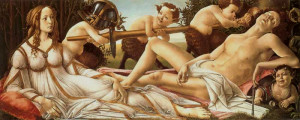PREVIOUS: VAN EYCK, THE ARNOLFINI PORTRAIT
Sandro Botticelli: Venus and Mars: about 1480-90
We’re back across the Alps to Florence for this painting, Botticelli’s Venus and Mars. Venus, the god of Love, reclines on a red cushion watching her lover Mars, the god of War, as he sleeps on a pink blanket.
And it’s a deep, deep sleep. Not even one of the satyrs, the mischievous half child, half goat creatures, blowing a conch in his ear can wake him.
I think we can guess what’s just been taking place, and if you want any more hints, look at the satyrs carrying off Mars’s lance – pick the Freud out of that. But Botticelli is also making a broader point about love conquering all – make love, not war if you like. Mars is literally disarmed after the act of love, his armour, helmet and weapons carried away while he sleeps.
The wonderful diaphanous effect of Venus’s gown was achieved by Botticelli first painting the leg of Venus, then painting the gown over the top of this with “hatching” – a criss-cross technique that makes the gown seem translucent.
We think this was the backboard to a bench or more probably a chest called a cassone, and was painted for a bedchamber to celebrate a marriage, perhaps even as a wedding gift. And who might it be for? Well, if you look near Mars’s head you will see a little swarm of wasps. In Italian wasps are vespe and we know that the Vespucci family were patrons of Botticelli, so this could be a visual pun to show that the painting was commissioned for someone in that family.
Botticelli was one of the leading artists of the Italian Renaissance, that flowering of art and culture that started in Florence in around 1400 and spread throughout Italy and northern Europe. The Renaissance rediscovered the forms and styles and ways of thinking of ancient Greece and Rome. (Renaissance means literally ‘rebirth’). So we see more representational art and we see more secular subject matter that, like the painting here, drew on classical myths and stories (although the dress of Venus, the armour of Mars, the jewels and the hairstyles aren’t taken from the classical period, but from 15th Century Florence).
However, despite belonging quite firmly to the Renaissance it uses an old-fashioned Florentine technique of a firm black line painted to define the figures – look at the chest and arms of Mars for example. It is also a mix of materials, with Botticelli experimenting with oil paints. These dry more slowly, but allow for much finer details, as we saw with the Arnolfini portrait. Botticelli has painted the figures and the foreground in the traditional tempera paint, but done the hedge in oils, almost as if he doesn’t yet trust the new medium.
The archetypical Renaissance Man was the painter, sculptor, engineer, inventor and all round polymath Leonardo da Vinci, and we’re going to look at one of his paintings next.
If you’d like to go face to face with this picture and have me tell you all about it, you can find out details and dates of my National Gallery guided tours here.


